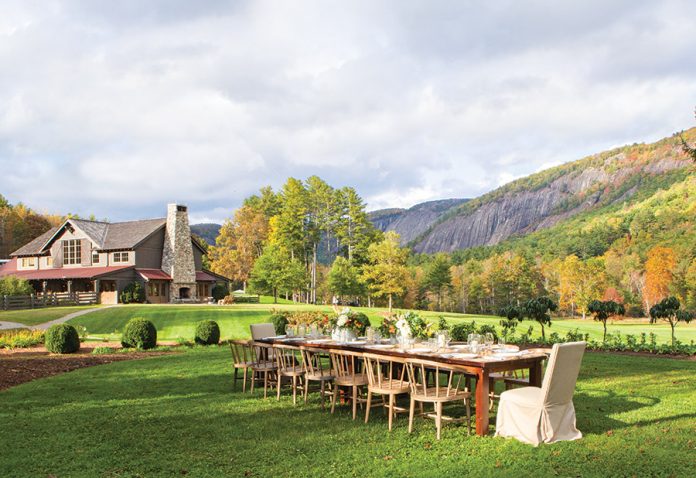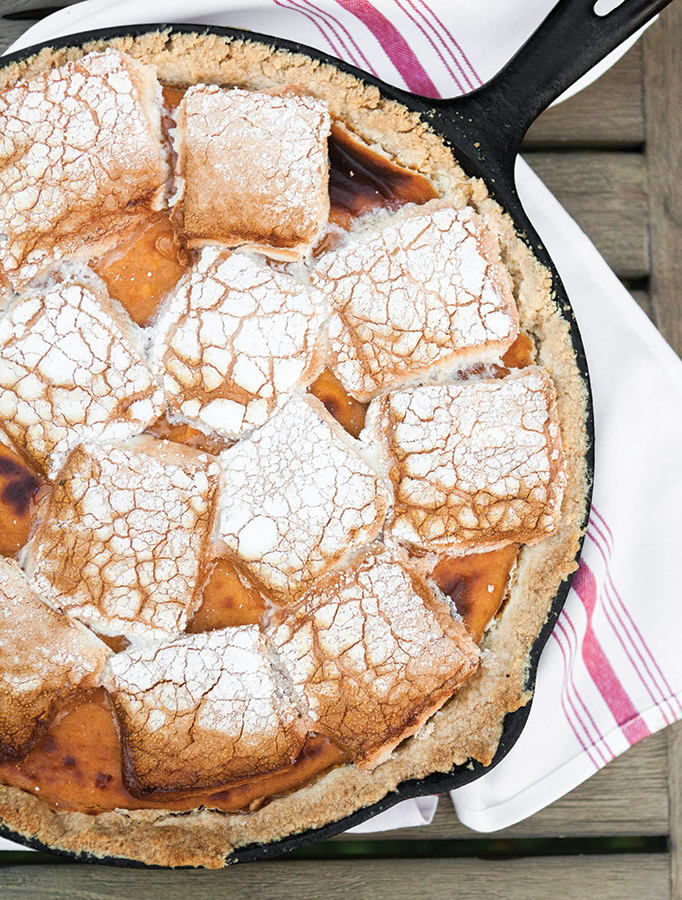By Ginny Heard
Photography by Whitney Ott/Vintage photos courtesy of Lonesome Valley
Nestled near the town of Cashiers in the beautiful Blue Ridge Mountains of North Carolina, Lonesome Valley is a captivating community encapsulated in a 700-acre box canyon. It’s also where proprietors and siblings Sally Jennings Eason, Dick Jennings, and Binford Jennings grew up. When Sally, Dick, and Binford’s great grandfather, E.H. Jennings, bought 50,000 acres of land in western North Carolina in 1895, he didn’t know he had set a story in motion, or that a long line of his descendants would later call this valley home.

As a matter of fact, when his initial plans to draw vacationing businessmen to the area were thwarted by natural disasters, he gave up, selling all but the 700 acres of Lonesome Valley.
With only this remnant left, he moved back north to Pittsburg, and not until his grandson, Richard Jennings, Jr., known as Dick, Jr., came along was anyone willing to take on the wilderness of Lonesome Valley. Now in his nineties, Dick, Jr. (father to Sally, Binford, and the third in a continuing line of Richards, Dick III) was in school at Yale when he decided he wanted to be a man of the land instead. “He told his family in Pittsburg that he wanted to move to his grandfather’s land in the mountains of North Carolina to see if he could farm there,” Sally says. “They thought he’d lost his mind and told him he’d starve to death, which is all he needed to hear to spur him on to try it.” He made his way down to the valley in 1948 and saw opportunity in the fresh, fast-flowing mountain streams. He had visited a trout farmer in Wisconsin to see how a trout farm was run, and he put together his own process based on this knowledge. “He could build anything, and he just cobbled up a trout farm, and in the process he also befriended the mountain folk who lived in the tiny community of Cashiers,” Sally says. “He’s too modest to talk about it much, but he loved them and did many things for the town—he built a community center, sent kids to college, and worked to make it a more congenial and thriving place.”

His farm was thriving, too. In the early days, he was raising trout to stock lakes, ponds, and streams. By 1980, he began to think about selling trout filets to grocery stores and restaurants, and the trout business took off. Sally came on board in the mid-1980s to help run the trout farm, which had been relocated to nearby Waynesville. Sally took over the marketing, determined to push their products like smoked trout and caviar to bring the fish to mainstream popularity. In 1996, they renamed the business Sunburst Trout Farms, an ode to the area’s logging community that was booming in the early 1900s. “My father started the trout farm in Lonesome Valley, but then took the show on the road,” Sally says.
They have more than 600 chef customers now—folks from all over the country are buying their trout. “Chefs these days want a story behind the food, and customers like to know that chefs are sourcing from honorable places,” she explains. It’s become a family business—after college and a few forays into their own ventures, Sally’s children, Wes, Ben, and Kate, have all heard the call of home.

“Working on the farm was a big part of our early life,” Sally says. “We thought it was normal to have jobs around the farm at age six.” These were small jobs; Sally watered the mink—another farming venture of her father’s—and her brother Dick remembers walking behind a bulldozer sorting the roots and rocks it turned up. “They were simple tasks,” Sally says. “I really think our folks were just trying to teach us that it is important to work hard, and that if you do something as a family, you have to be committed.”
It wasn’t all work on the farm, though. “These were days when you were allowed to explore on your own, even when you were young,” Sally says. Dick remembers winters when he would take aim with his .22 rifle and dislodge thousand-foot icicles from the canyon wall. “They were gigantic,” he says. “They covered the mountain and would take a full minute to make it all the way down.”
They were often left to their own devices, but this allowed them to learn to appreciate the pasture, the woods, and the streams. “You were always outside doing something,” Dick explains. “Digging, climbing, running—these helped us form a better imagination than sitting and watching television.” Sally and Dick each knew they wanted to raise their children there so they could have the same experience.

These childhood memories accumulated into a deep, shared love of Lonesome Valley. “My dad asked me to take over and maintain Lonesome Valley when I was twenty-four,” Dick says. Eventually, Dick and his siblings had to start talking about what taking care of the valley really meant. By 2002, developers were gaining interest in the valley, and the Jennings siblings wondered if that was the right way to go. At the time, there were nine children between them, some divorces, and an uncertainty about what would happen to the valley after Sally, Dick, and Binford were gone. This wasn’t satisfactory to the three—they wanted the valley preserved and appreciated in all its glory. So, they decided to develop the land themselves.
“We didn’t want it to be like a traditional development at all,” Sally explains. They wanted it to still feel like Lonesome Valley. “We wanted the view to always be the same as we knew it,” Dick says. Somewhat unusually for siblings, these three fall all over themselves giving credit to one another. “Dick is really the one with the vision,” Sally asserts. Their childhood in the valley was centered around family, nature, and enjoying the simple things in life. “We just needed to draw in people who are like us and who would appreciate the land for what it is,” Dick explains. Sally thought this was a tall order—but they decided to attempt it anyway.
“It went well for the first three years or so, and then the recession hit in 2008,” Dick says. But patience prevailed, and as the economy slowly recovered, so did development on Lonesome Valley. They added wilderness trails for hiking and picnics, a fitness center with a view, and a spa to the existing natural amenities of the ponds and streams. But it was Sally’s idea to open a top-notch restaurant as a way to draw people in.

“I’ll never forget Dick’s response: ‘Like an Applebee’s?’ he asked. ‘No…that’s not exactly what I was thinking,’” laughs Sally. She was thinking instead of all the great chef contacts she had made through Sunburst Trout Farms. One such contact, John Fleer, had left Blackberry Farm a few years before, and when he came to visit the area, he quickly fell in love. He came and opened Canyon Kitchen in the high-ceilinged barn-style building in 2009. With massive oak beams above and views of rolling meadows and canyon walls from three sides, dinner here is more than a meal—it’s an experience. “Of course, he made it rock solid from the day the doors opened,” Sally says. In 2014, though, John opened his own restaurant, Rhubarb, in Asheville, and in 2015 turned the kitchen over to the current chef, Adam Hayes. Adam was a Sunburst Trout Farms customer as well, and after years of working in well-respected restaurants, he was ready to get back to his roots in the North Carolina mountains. “I found out that he wasn’t satisfied where he was, so I called him and told him he needed to move back to the mountains, and that I had a job for him,” Sally says.
“It’s amazing how things work out,” Adam says. “I had just been telling myself I needed to make a change, and four days later I got Sally’s call.” So he left a world of meetings and conference calls to join one with an intense connection to its landscape. Using locally sourced ingredients (often from Lonesome Valley’s own gardens), Adam curates a daily menu that responds to seasonality, and therefore changes “due to availability, quality, or the whim of the chef.” This fits Adam’s “shoot from the hip” culinary mentality—an innovative knack for making showstopping dishes with whatever is available. Luckily for him, the area abounds with fresh and varied ingredients year-round, giving him ample opportunity to flex his creative muscle.

“He cooks to the land,” Sally says. “He couldn’t fit in with our vision any better.” On special occasions at Lonesome Valley, Adam will put on outdoor dinners for residents. He’ll serve dishes like crispy cast-iron cornbread, lemon and fennel-stuffed trout, collard greens, and housemade sausages. “At the last dinner, I had the sausages draped over the fire to smoke, and the juices were falling and sizzling on the stones below, so I moved the skillet full of collard greens under them to catch all of that flavor,” he says.
Adam’s passion for honoring the terrior of the landscape perfectly mirrors Sally, Dick, and Binford’s preservation ideals. And though the development project has not been without its obstacles thanks to a difficult economy, they’ve found that wonderful surprises can come out of the bad.
As a matter of fact, with its beautiful canyon view, amenities, and lower dues, Lonesome Valley has become a beacon to those looking to buy proparty in the area. “We’ve drawn the kind of folks who love the beauty and simplicity of the valley,” Dick says. “I’d never have uttered these words during the recession (I don’t think I slept for a few years) but it’s all ended up for the best.”

Happy to be preserving memories, nature, and their family legacy, Sally, Dick, and Binford all continue to follow in their father’s footsteps with hard work and strong wills. And with the folks that are joining them in celebrating the beauty and simplicity of this land, it seems that the valley isn’t so lonesome after all.
To find out more about Lonesome Valley or to make reservations at Canyon Kitchen (open Wednesday through Sunday for dinner, mid-May through early October), visit their website here. To purchase Sunburst Trout, visit website here.





